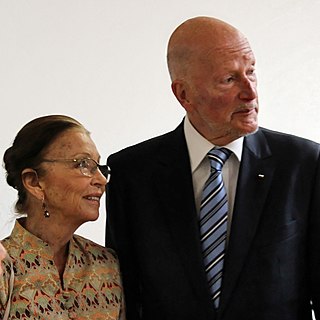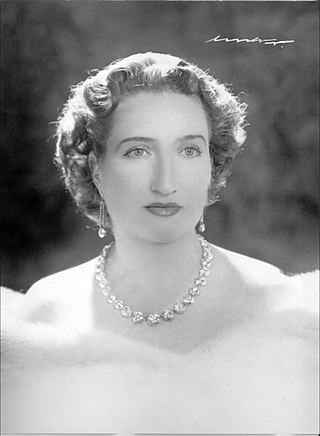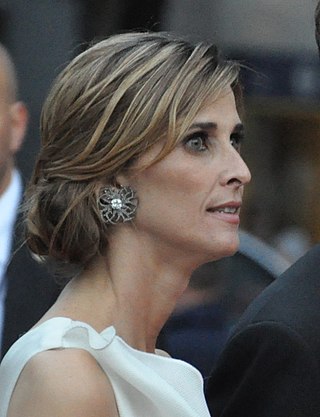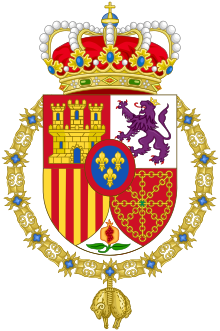
Infanta Cristina is the younger daughter of King Juan Carlos I and his wife, Queen Sofía. She is sixth in the line of succession to the Spanish throne, after her brother King Felipe VI's children, her sister Infanta Elena, Duchess of Lugo, and Elena's children.

The monarchy of Spain or Spanish monarchy is the constitutional form of government of Spain. It consists of a hereditary monarch that reigns as the head of state, being the highest office of the country. The current King is Felipe VI since 19 June 2014, after the abdication of his father, King Juan Carlos I.

Infante Juan, Count of Barcelona, was a claimant to the Spanish throne as Juan III. He was the third son and designated heir of King Alfonso XIII of Spain and Queen Victoria Eugenie of Battenberg. His father was replaced by the Second Spanish Republic in 1931. Juan's son Juan Carlos I became king when Spain's constitutional monarchy was restored in 1975.

Infanta Pilar of Spain, Duchess of Badajoz and Viscountess of La Torre, sometimes known more simply as Pilar de Borbón, was the elder daughter of Infante Juan, Count of Barcelona and Princess María Mercedes of the Two Sicilies, and older sister of King Juan Carlos I.

Margarita Gómez-Acebo y Cejuela is the wife of Tsar Simeon II of Bulgaria, whom she married after he went into exile. As such, she is also sometimes styled Tsaritsa Margarita; in this context, she may be styled as Princess of Saxe-Coburg and Gotha and Duchess in Saxony, due to her husband's descent from those former ruling families. During her husband's tenure as Prime Minister of Bulgaria, she was sometimes referred as Margarita Saxe-Coburg-Gotha. The current Bulgarian government does not recognize the titles in exile of the former Bulgarian royal family.

Victoria Federica de Todos los Santos de Marichalar y Borbón, Lady of Tejada is the younger child and only daughter of Infanta Elena, Duchess of Lugo, and Jaime de Marichalar. She is a granddaughter of King Juan Carlos I and Queen Sofía of Spain and a niece of King Felipe VI. Victoria is fifth in the line of succession to the Spanish throne after her cousins, King Felipe's daughters Leonor, Princess of Asturias, and Infanta Sofía; her mother; and her brother, Felipe.

Jaime de Marichalar y Sáenz de Tejada, Lord of Tejada, is the former husband of the Infanta Elena, Duchess of Lugo, the eldest daughter of King Juan Carlos and Queen Sofia of Spain.

Infanta Margarita of Spain, Duchess of Soria, 2nd Duchess of Hernani, Grandee of Spain, is the younger sister of King Juan Carlos and aunt of the reigning King Felipe VI of Spain.
The Spanish royal family, a branch of the House of Bourbon, is headed by King Felipe VI, and currently consists of Queen Letizia, their children Leonor, Princess of Asturias and Infanta Sofía of Spain, and Felipe's parents, King Juan Carlos I and Queen Sofía. The royal family lives at the Zarzuela Palace in Madrid, although their official residence is the Royal Palace of Madrid. The membership of the royal family is defined by royal decree and consists of: the King of Spain, the monarch's spouse, the monarch's parents, his children, and the heir to the Spanish throne.

Leonor, Princess of Asturias is the heiress presumptive to the Spanish throne. She is the elder daughter of King Felipe VI and Queen Letizia.

DomSebastian Gabriel de Borbón y Braganza, Infante of Portugal and Spain, was an Iberian prince of the 19th century, progenitor of the Spanish ducal lines of Hernani, Ansola, Dúrcal and Marchena, and Carlist army commander in the First Carlist War.

Princess María de las Mercedes of Bourbon-Two Sicilies was a member of the Spanish royal family and the mother of King Juan Carlos I.

Princess Alicia of Bourbon-Parma was a Spanish infanta. A member of the House of Bourbon-Parma, she became Duchess of Calabria through her marriage to Infante Alfonso, Duke of Calabria. She occasionally undertook official duties on behalf of the Spanish monarchy. Through marriage, she was the maternal half-aunt of King Juan Carlos I of Spain. She was the longest-lived Infanta of Spain.

Carlos Emilio Juan Zurita y Delgado, Duke of Soria and Hernani, is a Spanish physician and the husband of Infanta Margarita, Duchess of Soria. He is a brother-in-law of King Juan Carlos I and the uncle of the current Spanish king, Felipe VI.

Infanta Elena, Duchess of Lugo, is the first child and eldest daughter of King Juan Carlos I and Queen Sofía. As the eldest sister of King Felipe VI, Elena is the third in the line of succession to the Spanish throne. She has another younger sister, Infanta Cristina.

María del Rosario Nadal y Fuster de Puigdórfila, also known as the Princess of Preslav, is a Spanish consultant, art director, and former model. A former muse for Valentino, she works as an independent adviser to private art collectors and serves as the deputy director of the Colección Jumex. She is a senior member of the Bulgarian royal family as the estranged wife of Kyril, Prince of Preslav, from whom she separated in 2009.

Infante of Spain is a royal title normally granted at birth to the children of reigning and past Spanish monarchs, and to the children of the heir to the Crown. Individuals holding the title of infante also enjoy the style of Royal Highness.

Duchess of Badajoz, named after the city of Badajoz in Extremadura, was a substantive title It was created on 17 April 1967 by King Juan Carlos I, as the reason for the marriage between his older sister, the Infanta Pilar, and Luis Gómez-Acebo in 1967. It does not include any territorial landholdings and does not produce any revenue for the title-holder.

The wedding of Infanta Elena of Spain and Don Jaime de Marichalar y Sáenz de Tejada, Lord of Tejada, took place on Saturday, 18 March 1995 at Seville Cathedral in Seville, Andalusia.

DonLuis Gómez-Acebo y Duque de Estrada, Duke of Badajoz, 2nd Viscount of La Torre,, was a Spanish aristocrat and businessman. He was the husband of Infanta Pilar, sister of King Juan Carlos.



















